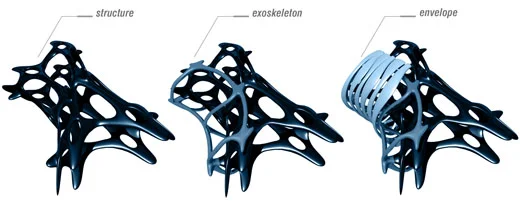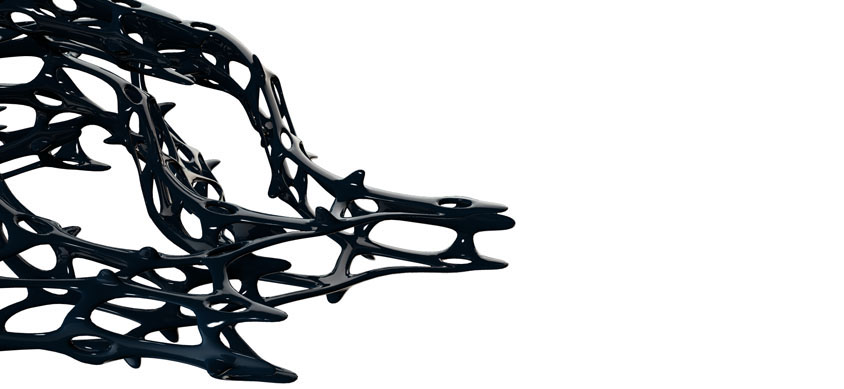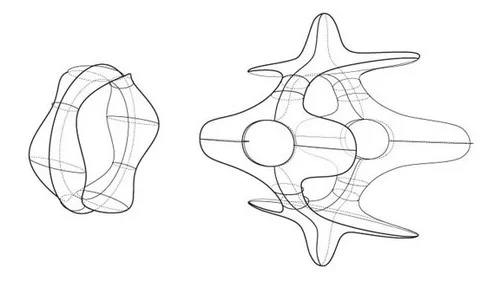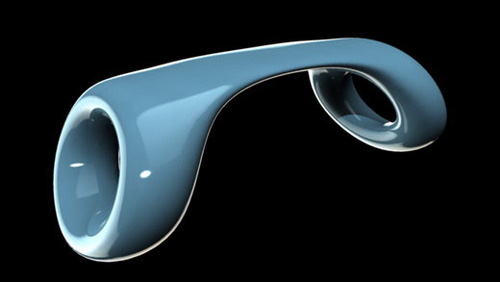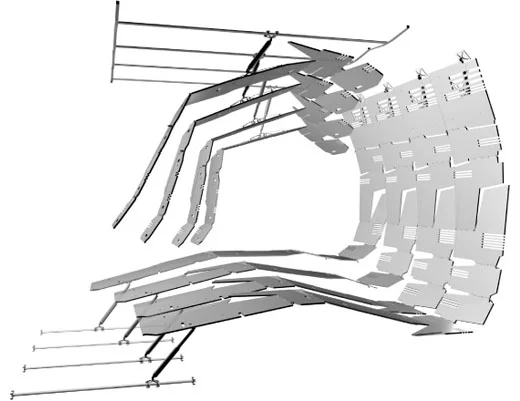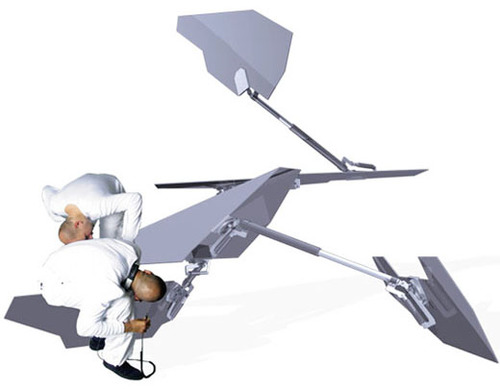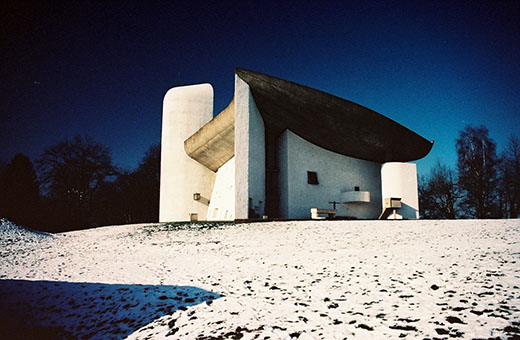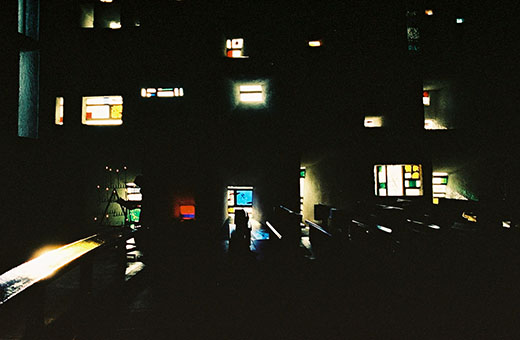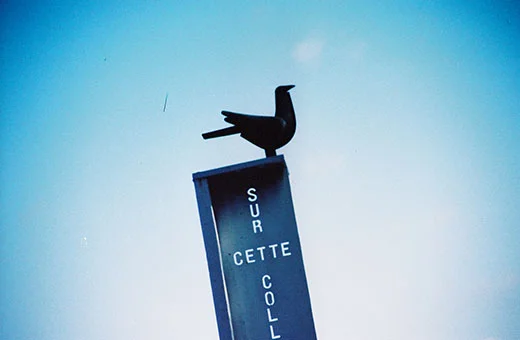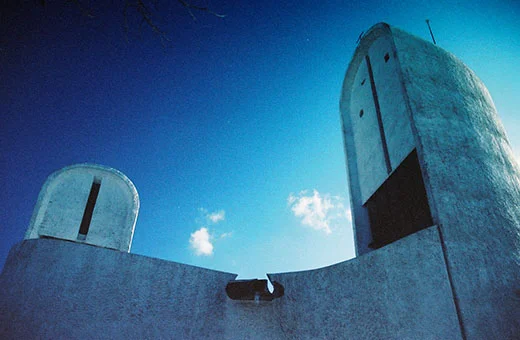Here are a couple of views from the building systems project I’m collaboratively designing with David Boira, Dylan Baker Rice, and Andrew Payne. Our proposal is for a double glazed facade system with mechanical louvers, exposed structure, and HVAC components all used as decorative elements.
Perth Amboy Competition Exhibit
Perth Amboy High School » Concept Rendering
Perth Amboy High School » Model
The competition design for Perth Amboy High School that I did with Eric Goldemberg at Eisenman Architects, is going to be exhibited along with the other finalists at the Architectural League of New York. We took second place behind John Ronan. Check out the competition website here.
Enclosure Strategy
I’m working with three components to develop a megastructure, exoskeleton, and cladding system for my studio project. They have a top down parametric relationship to each other based on the operation of the kinematic armatures that drive the form.
Topological Branching
One of the issues driving my work this semester is a frustration with the inadequacy of surfaces and their inherent thinness. I’m trying to find a way to make enclosure and space, not based on folded and curved planes, but with an idea of a thickened topology. I’m trying to develop something that can be inhabited, that has built in intelligence into how it organizes and structures itself, and whose operations open up new types of spatial and ornamental effects. The dense branching of the complex topology above is produced by the kinematic organization of multiple arrays of individual components and a subsequent phase shift of their topological order into one mega surface.
Subdivision Components
As part of my project in Hernan Diaz Alonso's studio, I’m working on the design of two components that could accumulate in multiple vectors. As they align with the connection point of another component they will opportunistically merge to create structure or enclosure. The idea is to use dynamically-driven kinematic armatures to make branches that compose complex three dimensional topologies.
Subdivision Surfaces
An example of two subdivision components
An example of subdivision surface attachment
Subdivision surfaces were recently included in the new release of Maya and I've been experimenting with them quite a bit. I've figured out that they offer a way to make seamless connections between topologically distinct pieces ( I assume this is probably not much of a secret in the animation world). This is pretty significant as it solves a lot of problems fundamental to nurbs modeling (while it raises many new ones).
Kinematic Curvature
While I was working for Peter Eisenman last summer, he freaked out on me about a curve I drew poorly. The upside was that he sat down for half-an-hour to explain the properties of a good curve. It had much to do with a gradual increase in its degree of curvature, and a bit to do with something ineffable. Regardless, I’ve discovered a better way to make consistently elegant curves.
Playing around with inverse kinematics and dynamics in Maya, I figured out that you can produce curves with a kinematic armature that have gradual parametric curvature. This solves the inherent problem in splines and nurbs that there are no qualitative or performative restraints. I did some research into this and it is a concept that apparently already exists.
Kinematic curves are curves produced by machinery, or a combination of motions, as distinguished from mathematical curves. The appeal of this should be quite clear, we can produce precise machined curvatures that are free of the constraints of mathematically defined curves. I ‘m pretty sure I will be basing the rest of the semester on trying to maximize this potential in my project.
Recon X + Space
This is a concept image for an animation I’m making with David Boira using our recon X piece from last semester. The premise is that it is in space – always a good idea for a sequel.
Los Angeles
Here are two photos I took with my Leica M5 while in LA. The first is deep in the Valley and the other on Santa Monica Blvd. The saturated colors come from cross processing Fuji Velvia slide film.
9th Ward
Action
Here is a ghosted perspective of the reconfigurable interior surfaces David Boira and I presented during our final review.
Reconfigurable Housing
David Boira and I have worked out these prototypes for reconfigurable housing modules. Following a flexible grid, these units can plug into a larger housing block and still retain their individuality by taking on different spatial and environmental configurations. On the interior, this performance is enhanced by floors and walls which can similarly be customized or rearranged for different uses.
Articulation Assist Surface
David Boira and I are working on translating our ideas from our reconfigurable furniture into a more specific architectural space by producing a wall and / or floor panel system. These surfaces are designed to produce varying degrees of folding with real time articulation assist. When panels are pushed or pulled, an electric actuator exerts force in the direction of the pull, making the hinged surface fold with no effort into shelves, tables, chairs, or whatever other arrangement one desires.
Figuring It Out
We're still figuring this thing out. So are these guys.
reCon-X Expanded Color Test
We are testing out the motion of reCon-X and trying out some color schemes while we are at it.
reCon-X
David Boira and I are partners this semester in a housing research design studio. In a somewhat related spin off, we are making this highly articulated yet completely de-calibrated furniture object. It is a piece that comes with no agenda other than encouraging the user to figure out their own potential uses by reconfiguring it into different spatial and performative organizations. It will be made from water-jet cut aluminum panels, cnc milled hinge plates, and automotive linear actuators.
Ronchamp
Kevin West, a friend, writer, and editor of W Magazine, drove me from Paris to Ronhamp because it was something that he thought we had to do. I wasn’t that interested for some reason or another, I think I wanted to go to Switzerland. I was wrong. These photos from my Land Camera don’t do it any bit of justice.
Fourth of July
Hell yeah.
Eisenman Architecture
Good news. I'll be working for Peter Eisenman this summer.
Animated Title Sequence
I'm working with Noah Olmsted and Adam Marcus on a animated title sequence for an short movie we're making in Introduction to Digital Design.





